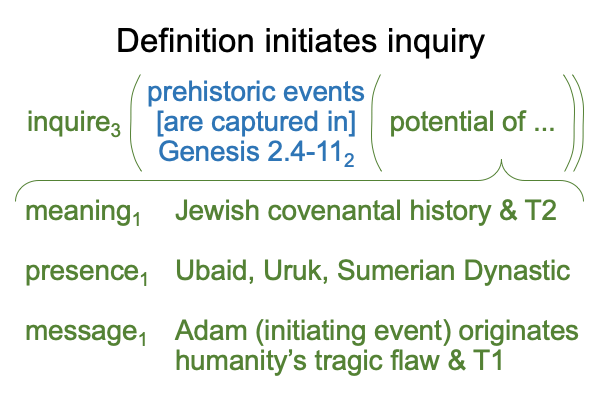0093 I return to the nested form obtained from examining Part One.
Part Two transforms the definition of Genesis 2.4-11 as mytho-history into an inquiry into the reality of the historical Adam.
Here is how the definition in Part One transforms at the end of Part Two.

0094 Craig’s definition of the stories of Adam and Eve as mytho-history changes the presence underling the Primeval History and initiates an inquiry into the Ubaid, Uruk and Sumerian Dynastic archaeological periods. The presence underlying Genesis 2:4-11 (and the origin myths of the ancient Near East) describes a recent creation of humans by God (or gods). By “recent”, I mean, the start of the Ubaid.
0095 Does this fly in the face of the scientific narrative of human evolution?
Does the start of the Ubaid mark a (yet to be appreciated) transition in human evolution?
0096 Why haven’t archaeologists proposed such a transition?
Well, it turns out, they have. A rule-of-thumb gained currency in archaeology in the first half of the twentieth century. It goes like this. The further from southern Mesopotamia, the later the civilization appears.
0097 In sum, the stories of Adam and Eve associate to a prehistoric trauma, corresponding to the start of the Ubaid. In this trauma, the traditions of the deep past cannot be remembered, so humankind must be created from scratch (as far as mythology goes). The trauma (represented by Adam’s story) originates humanity’s tragic flaw. This flaw touches base with the first theme (T1). Humankind tends to destroy what God has made good.
0098 Chapter 6 (B’) poses the question, “Are myths believed to be true?”
The answer is, “Yes, if every element in the three-level interscope is filled in.”
Intellectual satisfaction proceeds from a completely associated three-level interscope.
The proof is in the way that the ten family resemblances of myth associate to all elements in the three-level interscope.
Myths that contain all family resemblances offer understanding.
0099 Understanding?
Is “understanding” is another way to say, “This is the way it must be.”
Not all historical processes and events are accessible to Western scientific articulation. For example, a prehistoric event cannot be fully described as history.
It can be described through myth.
0100 In the case of Genesis 2:4-11 and the origin stories of the ancient Near East, these historical events and processes associate to the Ubaid, the Uruk and the Sumerian Dynastic.
In other words, prehistoric events are memorialized as myth, in Genesis 2:4-11.
We know that they associate with the start of civilization in the ancient Near East.
We can also imagine that Genesis 2.4-11 contains clues that point to those prehistoric events.
